
Technical Report NTB 02-10
Project Opalinus ClayRadionuclide concentration limits in the near-field of a repository for spent fuel and vitrified high-level waste
The disposal feasibility study currently performed by Nagra includes a succession of quantitative models, aiming at describing the fate of radionuclides potentially escaping from the repository system. In this chain of models the present report provides the so called "solubility limits" (maximum expected concentrations) for safety relevant radionuclides from SF/HLW wastes, disposed of in a reducing clay (Opalinus Clay, bentonite) environment.
Solubility and speciation calculations in bentonite pore waters were performed using the very recently updated Nagra/PSI Chemical Thermodynamic Data Base (TDB) for the majority of the 37 elements addressed as potentially relevant. Particularly for the most relevant actinides, the straightforward applications with this updated TDB yielded results in contradiction to chemical analogy considerations. This was a consequence of incomplete data and called for problem specific TDB extensions, which were evaluated in a separate study. However, a summary of these problem specific extensions is provided in section 4.1.
The results presented in this report solely depend on geochemical model calculations. Thus, it is of utmost importance that the underlying data and assumptions are made clear to the reader. In order to ensure traceability, all thermodynamic data not included in the Nagra/PSI TDB are explicitly specified in the report, in order to provide complete documentation for quality assurance and for comprehensibility.
In order to clearly distinguish between results derived from data carefully reviewed in the Nagra/PSI TDB and those calculated from "other" data, the summary of expected maximum concentrations provided in Table 1 includes two columns. The heading CALCULATED provides maximum concentrations based on data fully documented in the updated TDB, whereas maximum concentrations, which include additional problem specific data and/or data from other sources, are given under the heading RECOMMENDED.
The present study also pays specific attention to the uncertainties of evaluated maximum concentrations and represents them as lower- and upper limits. The conceptual steps for deriving uncertainties are briefly outlined in section 3. Mainly due to lack of data/knowledge, it was not always possible to assess uncertainties in a manner consistent with that used to assess maximum concentrations. In a number of cases it was necessary to rely on less well traceable information or even on estimates and/or "expert judgement" to provide uncertainties. This less rigorous approach is justified by the fact that uncertainties (particularly the upper limits) are deemed as important as the maximum concentrations themselves. Although (upper) limits are specified wherever adequate information was available, no uncertainties at all could be derived for a few elements.
A specific class of variabilities arises from major uncertainties in the underlying chemical system, particularly from lack of knowledge of the partial pressure of CO2. This class of uncertainties is visualised as "solubility" vs. "pCO2" diagrams when appropriate. Limits were derived either from maximum values of thermodynamic uncertainties or from chemical system variabilities.
Another major uncertainty concerns the definition of redox conditions in the underlying chemical system. Although not really expected to occur, an oxidising environment instead of reducing conditions could establish in the vicinity of the disposed of wastes. In the sense of a "what-if" study, section 5 provides model calculations for the redox sensitive elements Pu, Np, U, Tc, Se and Sb, performed under oxidising conditions.
